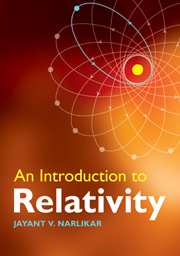Book contents
- Frontmatter
- Contents
- Preface
- 1 The special theory of relativity
- 2 From the special to the general theory of relativity
- 3 Vectors and tensors
- 4 Covariant differentiation
- 5 Curvature of spacetime
- 6 Spacetime symmetries
- 7 Physics in curved spacetime
- 8 Einstein's equations
- 9 The Schwarzschild solution
- 10 Experimental tests of general relativity
- 11 Gravitational radiation
- 12 Relativistic astrophysics
- 13 Black holes
- 14 The expanding Universe
- 15 Friedmann models
- 16 The early Universe
- 17 Observational cosmology
- 18 Beyond relativity
- References
- Index
15 - Friedmann models
Published online by Cambridge University Press: 05 June 2012
- Frontmatter
- Contents
- Preface
- 1 The special theory of relativity
- 2 From the special to the general theory of relativity
- 3 Vectors and tensors
- 4 Covariant differentiation
- 5 Curvature of spacetime
- 6 Spacetime symmetries
- 7 Physics in curved spacetime
- 8 Einstein's equations
- 9 The Schwarzschild solution
- 10 Experimental tests of general relativity
- 11 Gravitational radiation
- 12 Relativistic astrophysics
- 13 Black holes
- 14 The expanding Universe
- 15 Friedmann models
- 16 The early Universe
- 17 Observational cosmology
- 18 Beyond relativity
- References
- Index
Summary
Introduction
The work covered in Chapter 14 did not tell us two important items of information about the Universe: (1) the rate at which it expands as given by the function S(t); and (2) whether its spatial sections t = constant are open or closed as indicated by the parameter k. To find answers to these questions, it is necessary to go beyond the Weyl postulate and the cosmological principle. We require a dynamical theory that tells us how the scale factor and curvature are determined by the matter/radiation contents of the universe.
A comparison of Newton's law of gravitation with the general theory of relativity shows the latter as enjoying advantages both on the theoretical and on the observational front. General relativity gets round the criticism of Newtonian gravity of violating the light-speed limit. It allows for the permanence of gravitation by identifying its effect with the curvature of spacetime. Observationally it performs better vis-à-vis the Solar-System tests and explains the shrinking of binaries through gravitational radiation. It therefore generates greater confidence than Newton's approach does, especially for use in cosmology, where strong gravitational fields are likely to be involved and where distances are so large that the assumption of instantaneous action at a distance would be misleading. Hence we will adopt general relativity as the underlying theory for constructing models of the Universe.
We will now undertake that exercise by constructing the models which Friedmann in 1922–4 and Lemaître in 1927 came up with before Hubble's results became known.
- Type
- Chapter
- Information
- An Introduction to Relativity , pp. 245 - 274Publisher: Cambridge University PressPrint publication year: 2010



